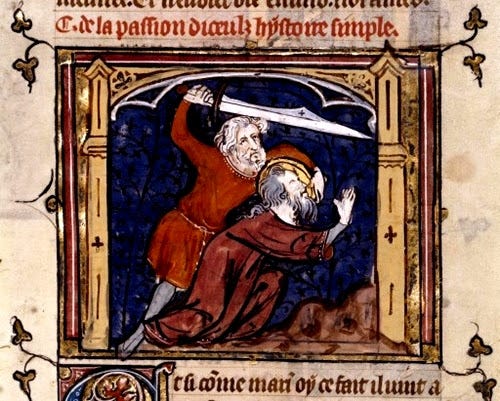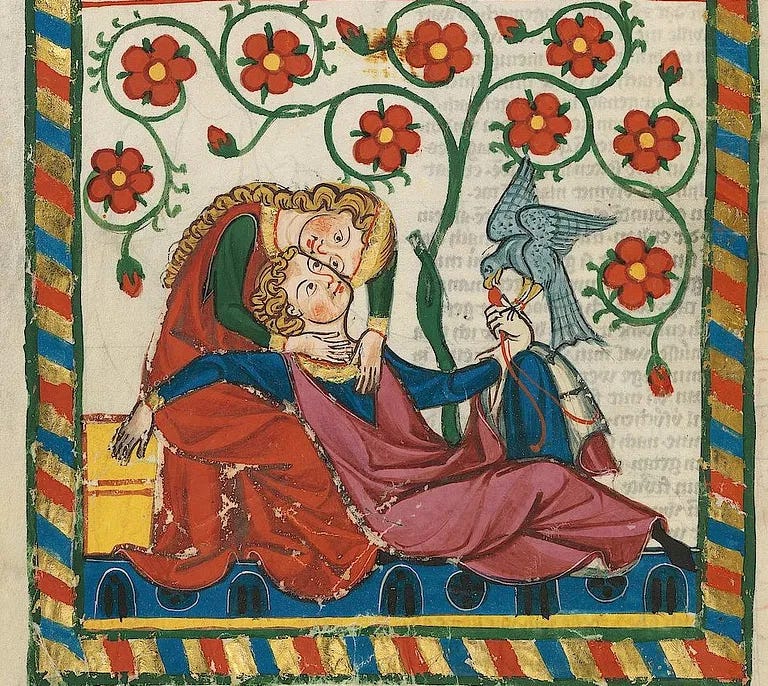Come and see me in London, Sheffield, Shrewsbury and a whole host of other places where I’m performing my new show God, the Bible and Everything (in 60 minutes). And if your town isn’t listed on the tour so far, you could make a gig happen at your church. Why not get in touch?
We are reaching the brief period in the calendar when the cost of red roses doubles. This is because of St Valentine, whose feast day falls on 14th February. In fact, it’s no longer a feast day. The Roman Catholic church dropped the celebration entirely in 1969. Valentine clung onto the liturgical calendar in England, however, where he is commemorated as “Martyr at Rome c.269”.
It may seem implausible but Valentine’s role as a Christian cupid is, in fact, an invention of an Englishman. Geoffrey Chaucer (c1340-1400), best known for his Canterbury Tales, wrote another poem in which he linked the Feast of St Valentine with the pursuit of love.
The Parliament of Fowls is a poem of about 700 lines written by Chaucer in around 1382. The year suggests that it was meant to be a celebration of the engagement of King Richard II of England to Anne of Bohemia. The poem is a dream or vision about birds gathering on St. Valentine’s Day to select mates. As three noble eagles compete for a female eagle who is free to choose, the virtue of free will in romantic love is emphasised.
As a firm feature of life in the 14th century, Saints’ days were often used to give the date of something. For example, the massacre of Huguenots in France in 1572 took place on 24th August, St Bartholomew’s day, so it is known as St Bartholomew’s Day Massacre because of the coincidence of the date. There is a St Valentine’s Day Massacre in 1929 when seven members of ‘Bugsy’ Moran's gang were shot by Al Capone's men disguised as policemen.
Before 1382, St Valentine was not associated with romantic love. There were plenty of Arthurian legends in circulation that involved chivalrous knights, but not Valentine. He was a popular saint. Stories about this 3rd century Roman priest had been recorded in various Roman hagiographies (biographies of saints). He had, apparently, performed miraculous healings, including curing the son of an important Roman orator, converting his household to Christianity in the process. After his arrest and refusal to renounce his faith or make sacrifice to Roman gods, he was tortured and beheaded.
In 496, Valentine was honoured by Pope Gelasius I with a feast day on 14th February, believed to be the date of his martyrdom. As the Roman church grew, Valentine’s name spread across Christendom.
The Golden Legend
Valentine had been included in Jacobus de Voragine’s Golden Legend, a popular 13th-century ‘hall of fame’ compilation of 153 saints’ lives. In this book, Valentine was a ‘typical’ martyr whose faith was honoured in a noble death. Redolent of stories from the Acts of the Apostles, Valentine was said to have healed the blind daughter of his jailer, leading to the conversion of his household and many others. Before his execution, he sent the daughter a letter signed “Your Valentine.”
Once St Valentine’s Day had been linked to romance by Chaucer, this letter ending “your Valentine” took on a new meaning. In 1415, the Duke of Orléans, captured at Agincourt, wrote to his wife from the Tower of London calling her “my very sweet Valentine”. A letter from the Paston collection written in 1477 is addressed to “Most respected and honourable and my most dearly-beloved Valentine.” By 1601, Shakespeare has Ophelia lamenting in Hamlet:
“To-morrow is Saint Valentine’s day, all in the morning betime,
and I a maid at your window, to be your Valentine.”
Centuries later, red roses cost double in mid-February. You can thank Chaucer for that.
I’m not done yet, but if you’re finding this interesting, why not subscribe and get the next instalment of Cary’s Almanac every Friday lunchtime:
When Paganism Has a Disappointing Point
You might have heard that Valentine’s Day is derived from a Roman pagan festival which fell on 15th February. This is Lupercalia associated with fauns, fertility and feasting in which scantily clad men, the Luperci, would run around striking women with thongs made of goat hide.
I hope I have demonstrated how that simply isn’t the origin of St Valentine’s Day which only became associated with romance a thousand years after the Roman festival had declined. The problem is that our modern Valentine’s Day is also shot through with the spirit of Lupercalia which, like many pagan festivals, sounds like a wonderful opportunity to gratify our own desires.
Today, our society celebrates whatever love you wish to celebrate. We live in an era that says things like “the heart wants what the heart wants” and “love is love.” Challenge the notion that “love is love” and you will be accused of hate.
In The Parliament of Fowls, the novel romantic idea was that the female was allowed to choose the male. The notion that marriage was arranged and transactional was being challenged. Centuries later, that liberty to choose has grown to the point where we no longer know what to do with ourselves, our choices and our desires, when almost everything is permissible.
Valentine would have said that the Bible teaches us what love really is and what Christian liberty is for. So let us conclude with words from Galatians 5 written by the Apostle Paul who could be found in Pagan Rome only a few generations before Valentine. Paul wrote the letter to the church in pagan Galatia, where the ‘luperci’ were merely the tip of the iceberg. I urge you to read the whole chapter, but let us finish with verses 13-14, words that are as counter-cultural now as when they were written:
For you were called to freedom, brothers. Only do not use your freedom as an opportunity for the flesh, but through love serve one another. For the whole law is fulfilled in one word: “You shall love your neighbour as yourself.”
Why not read Galatians 5 out loud to your loved ones on Valentine’s Day? I’m sure it’s what Valentine would have wanted.
If you found that interesting, why not share it with someone?





FYI. Had issues booking for your show via credit card on your website - so resorted to using PayPal ;)